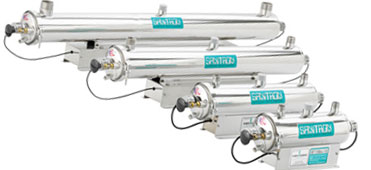Ultraviolet lamps
Owners of cottages, as well as businesses that use water from their own well, need to take care of water disinfection. Even chlorinated tap water in urban apartments often needs additional disinfection.
WHY AND HOW TO DISINFECT WATER

Water is a perfect breeding ground for all kinds of microorganisms, including pathogens. To avoid the harmful effects of germs and bacteria and to prevent their reproduction, water is disinfected. There are two main methods of disinfection: chemical and physical. An example of chemical disinfection is water chlorination, which is used in municipal treatment plants. Physical methods include boiling and ultraviolet disinfection. This treatment does not involve the use of reagents, which increases safety and environmental friendliness.
UV DISINFECTION - PRINCIPLE OF OPERATION
Water disinfection with ultraviolet is a reagent-free method which does not change the chemical composition of water and its physical properties. Bactericidal effect has only a medium-range UV radiation (250-270 nm). UV causes photochemical reactions in DNA and RNA molecules, leading to irreversible damage to microorganisms. The UV disinfection unit includes a tank into which water flows through the pipes. Inside the tank are UV lamps. The incoming water is exposed to ultraviolet radiation and then passes through the outlet pipes.

Untreated tap water contains mechanical impurities, metals, bacteria, pesticides, chemicals in varying amounts that accumulate in the body and can cause various diseases.

Water treatment helps get rid of the unpleasant taste and odor that appear as a result of an increase in the concentration of inorganic and organic substances in the composition of such water.

Lithuanian water leads to the accumulation of scale on the heating surfaces of electrical appliances, consequently reducing their thermal conductivity. This accelerates appliance failure and increases energy costs.

It is known that the consumption of clean water is extremely important for maintaining health. That is why purified water is necessary for a person to protect himself from many diseases and to continue an active life without doctors and pills.
ADVANTAGES AND DISADVANTAGES OF ULTRAVIOLET WATER DISINFECTION
Ultraviolet water disinfection units are found both in homes, factories and offices. The popularity of this type of installation is due to a number of advantages:
- No chemicals are used, so the taste of the water does not change;
- Efficiency. No need to replace cartridges, replacement of lamps is very rare.
- The cost of the disinfection unit itself is also relatively low;
- Easy to use and maintain, there is no need for a reagent farm;
- Environmentally friendly and safe;
- Quick impact and effectiveness against microorganisms of all kinds.
The disadvantages of the method include the possibility of recontamination of treated water. This is possible in the subsequent stages of treatment or during transportation.
Ultrafiltration and ultraviolet does not change the chemical structure of water because it does not add anything to the water and does not remove minerals. Learn more about ultraviolet water disinfection using R-Can equipment (Canada) as an example.
You can read more about Sterilight lamps in the next section.
own enterprise
customized solutions
operational experience
and installation






